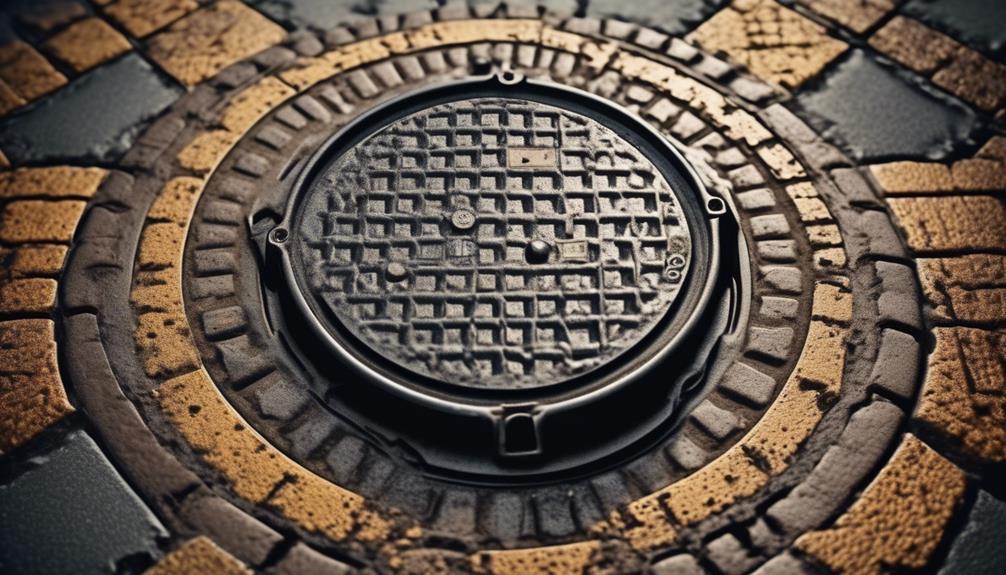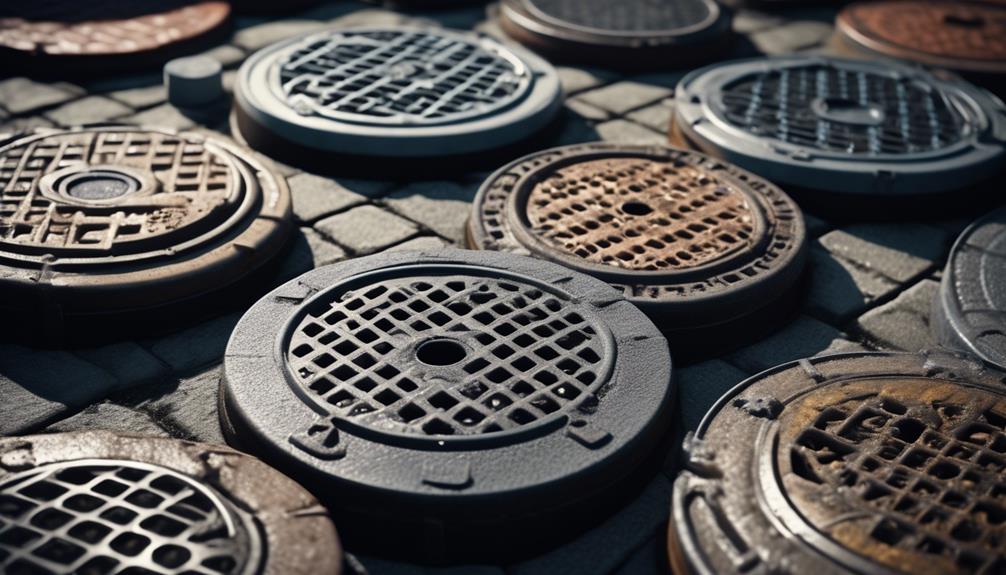Manhole covers, those seemingly inconspicuous lids found on the streets and sidewalks, serve a crucial purpose in our urban infrastructure. Their primary function is to provide access to underground utility systems, such as sewage and electrical networks. However, have you ever wondered how much these unassuming covers actually weigh? The weight of manhole covers can vary significantly depending on several factors, including their size, design, and the materials used. In this discussion, we will explore the average weight of manhole covers, the variations that exist, the common materials employed in their construction, and the safety considerations associated with handling these heavy objects. Prepare to be surprised by some interesting facts about manhole cover weight that you may not have considered before.
Key Takeaways
- Manhole covers are important for providing access to underground utility systems, ensuring public safety, and preventing unauthorized access.
- The weight of manhole covers can vary based on factors such as size, material, load requirements, and manufacturing process.
- The average weight of cast iron covers is 250-400 pounds, while ductile iron covers weigh 250-500 pounds, and composite materials weigh 50-150 pounds.
- Material selection for manhole covers should consider factors like durability, strength, corrosion resistance, and weight reduction.
The Purpose of Manhole Covers

Manhole covers serve as essential protective barriers that provide access to underground utility systems while ensuring public safety and preventing accidents or damage to the infrastructure. The purpose of manhole covers is to securely seal openings in the ground that lead to underground utility systems, such as sewer lines, water mains, or electrical cables. These covers are designed to withstand heavy loads, including pedestrian and vehicular traffic, and to provide a safe and stable surface for people to walk or drive over.
To fulfill their purpose effectively, manhole covers must be durable and resistant to wear and tear. They are typically made from materials such as cast iron, reinforced concrete, or composite materials that can withstand the weight of vehicles and other heavy objects. Additionally, manhole covers must be able to withstand environmental factors such as temperature changes, corrosion, and moisture.
Regular maintenance is essential to ensure the continued functionality of manhole covers. This includes inspecting them for any signs of damage, such as cracks or deformations, and repairing or replacing them as necessary. It is also important to maintain the surrounding area by keeping it clear of debris, vegetation, or any other obstructions that may hinder access to the manhole covers.
Factors Affecting Manhole Cover Weight
The weight of a manhole cover is determined by several factors that are crucial to its functionality and durability. These factors include the size and shape of the cover, the material used in its construction, and the load requirements specified for the particular application.
To give you a better understanding of how these factors affect the weight of a manhole cover, let's take a look at the following table:
| Factors | Description |
|---|---|
| Size and Shape | The dimensions and design of the manhole cover play a significant role in determining its weight. |
| Material | Different materials have varying densities, which directly impact the overall weight of the cover. |
| Load Requirements | Manhole covers are designed to withstand specific loads, and the weight is determined accordingly. |
The manufacturing process of manhole covers also contributes to their weight. Cast iron, which is a common material used in manhole cover production, is known for its durability and strength. However, it is also relatively heavy. On the other hand, materials like composite or lightweight metals can be used to reduce the weight of manhole covers while still maintaining their structural integrity.
It is important to consider the environmental impact of heavy manhole covers. Their weight affects transportation costs and fuel consumption during delivery. Additionally, heavier covers may require more effort to install and maintain. By using lighter materials or optimizing the design, the overall environmental impact of manhole covers can be reduced.
Average Weight of Manhole Covers

Considering the factors that determine the weight of manhole covers, it is important to examine the average weight of these covers for various applications. The weight of a manhole cover depends on several factors, including the size, shape, and material used in its construction. While there is no fixed weight for all manhole covers, we can provide an average range based on common materials used.
- Cast Iron:
- Average weight: 250-400 pounds
- Cast iron is the most common material used for manhole covers due to its durability and strength. It can withstand heavy traffic loads and provides excellent resistance against corrosion.
- Ductile Iron:
- Average weight: 250-500 pounds
- Ductile iron is a type of cast iron that has been treated to enhance its strength and toughness. It is often used in areas with high traffic or where a higher load capacity is required.
- Composite Materials:
- Average weight: 50-150 pounds
- Composite materials, such as fiberglass or reinforced plastic, are becoming increasingly popular for manhole covers. These materials offer a lighter alternative to traditional cast iron covers without compromising strength and durability.
It is important to note that the weight of manhole covers may vary depending on specific applications and local regulations. Additionally, some specialized covers, such as those used in airports or industrial facilities, may have different weight requirements to accommodate heavy machinery or vehicles.
Understanding the average weight of manhole covers can be helpful for professionals involved in the maintenance and installation of underground infrastructure. By knowing the weight range of different materials, they can select the appropriate cover for specific applications, ensuring safety and longevity.
Variations in Manhole Cover Weight
Different factors can contribute to variations in the weight of manhole covers. One of the primary factors is the material used in their construction. Manhole covers are typically made from materials such as cast iron, ductile iron, or composite materials like reinforced concrete or polymer. Each material has its advantages and disadvantages, which can affect the weight of the cover.
To emphasize the weight variations based on material options, let's consider a three-column, three-row table:
| Material | Average Weight (lbs) | Characteristics |
|---|---|---|
| Cast Iron | 250-350 | Durable, strong, resistant to corrosion |
| Ductile Iron | 350-500 | Higher strength, impact resistance, less brittle |
| Composite | 100-250 | Lightweight, corrosion-resistant, non-conductive |
As shown in the table, cast iron manhole covers typically weigh between 250-350 lbs, making them a reliable option due to their durability and resistance to corrosion. On the other hand, ductile iron covers offer higher strength and impact resistance, weighing between 350-500 lbs. Lastly, composite covers, which are made from lightweight materials like reinforced concrete or polymer, weigh between 100-250 lbs. These covers are corrosion-resistant and non-conductive, making them suitable for specific applications where weight reduction is a priority.
It is essential to consider these weight variations when selecting manhole covers for different applications. Factors such as traffic load, location, and accessibility should also be taken into account to ensure the safety and functionality of the covers. By understanding the weight variations and material options available, professionals can make informed decisions that meet the specific needs of their projects.
Common Materials Used for Manhole Covers

When it comes to choosing materials for manhole covers, there are several options available. Common materials used include cast iron, ductile iron, and composite materials. These materials vary in weight, with cast iron being heavier and more durable, while composite materials are lighter and resistant to corrosion. The choice of material depends on factors such as load-bearing capacity, durability, and cost.
Material Options for Manhole Covers
Manhole covers are commonly made from a variety of materials to ensure durability and functionality. The choice of material for manhole covers is crucial as it affects their durability and the environmental impact. Here are some common materials used for manhole covers:
- Cast Iron:
- Known for its strength and durability.
- Resistant to wear and tear, making it ideal for heavy traffic areas.
- Can withstand extreme weather conditions.
- Ductile Iron:
- Combines the strength of cast iron with greater flexibility.
- Offers excellent resistance to bending and impact.
- Has a longer lifespan compared to cast iron.
- Composite Materials:
- Made from a combination of polymers and reinforcing fibers.
- Lightweight and easy to handle.
- Resistant to corrosion and chemical damage.
Choosing the right material for manhole covers ensures their longevity and reduces the need for frequent replacements. Additionally, considering the environmental impact of the materials used helps in sustainable infrastructure development.
Weight Variations for Manhole Covers
The weight of manhole covers can vary depending on the material used for their construction. Material selection plays a crucial role in determining the load capacity and overall weight of a manhole cover. Different materials have different properties that affect their weight and load-bearing capabilities. For instance, cast iron is a common material used for manhole covers due to its strength and durability. Cast iron covers tend to be heavier compared to other materials such as aluminum or fiberglass, but they offer superior load capacity and can withstand heavy traffic loads. On the other hand, materials like aluminum or fiberglass are lighter in weight, making them easier to handle during installation or maintenance. However, they may have lower load capacities and may not be suitable for areas with heavy traffic or vehicular loads. Therefore, when selecting a manhole cover, it is important to consider the material's load capacity and weight to ensure it meets the specific requirements of the installation location.
Factors Affecting Cover Weight
Factors such as material composition and design intricacies significantly influence the weight of manhole covers. When it comes to cover design, several factors come into play.
- Material Composition:
- Cast Iron: Cast iron, known for its strength and durability, is a common material used for manhole covers. Its weight is influenced by the thickness and density of the iron used.
- Composite Materials: Manhole covers made from composite materials, such as reinforced concrete or fiberglass, are lighter in weight compared to cast iron covers.
- Design Shape:
- Round covers tend to be lighter than square or rectangular covers due to the distribution of weight and structural design.
- The presence of reinforcement ribs or additional structural elements can also increase the weight of the cover.
- Impact of Climate:
- In areas with extreme temperatures, such as hot summers or freezing winters, covers may be designed to be heavier to withstand thermal expansion and contraction.
Considering these factors, manufacturers carefully design manhole covers to ensure they meet the required weight specifications while maintaining strength and durability in various climates.
Safety Considerations for Heavy Manhole Covers

When dealing with heavy manhole covers, weight distribution concerns are paramount. Improper weight distribution can lead to instability, making the covers difficult to handle and increasing the risk of accidents or injuries. To ensure safe handling, it is essential to use appropriate lifting equipment that can support the weight and distribute it evenly, minimizing the strain on workers and preventing potential hazards.
Weight Distribution Concerns
Weight distribution concerns play a crucial role in ensuring the safety of heavy manhole covers. Proper weight distribution is essential to prevent structural failures, accidents, and injuries. Here are some important considerations regarding weight distribution for heavy manhole covers:
- Load bearing capacity: Manhole covers are designed to bear specific loads. It is important to ensure that the weight of the cover is evenly distributed over its surface area to avoid overloading certain parts. This helps maintain the structural integrity of the cover and prevents excessive stress on any particular point.
- Material selection: The choice of materials for manhole covers is critical to achieve optimal weight distribution. Different materials have varying load-bearing capacities and distribute weight differently. Selecting the right material based on load requirements and the surrounding environment is crucial for ensuring proper weight distribution.
- Installation: Proper installation techniques are essential for achieving optimal weight distribution. The cover should be securely placed in the frame and properly aligned to distribute weight evenly. This helps minimize any potential weak points and ensures that the load is evenly distributed across the cover's surface.
Lifting Equipment Requirements
To ensure the safe handling and installation of heavy manhole covers, it is crucial to adhere to specific lifting equipment requirements and implement necessary safety considerations. Lifting techniques play a vital role in preventing injuries and ensuring the efficient handling of manhole covers. When selecting lifting equipment, it is essential to consider the weight capacity limits of the equipment to avoid overloading and potential accidents. Different types of lifting equipment, such as cranes, hoists, and vacuum lifters, may be used depending on the weight and size of the manhole cover. These lifting devices should be inspected regularly to ensure their proper functioning and adherence to safety regulations. Additionally, proper training should be provided to workers to ensure they are aware of the correct lifting techniques and safety protocols when handling heavy manhole covers.
Interesting Facts About Manhole Cover Weight
Manhole cover weight is a vital consideration in urban infrastructure planning and maintenance. Manhole covers are heavy for several reasons, and understanding their weight can help ensure proper maintenance and safety. Here are some interesting facts about manhole cover weight:
- Variety of materials: Manhole covers are commonly made from materials such as cast iron, concrete, or composite materials. The choice of material depends on factors such as load-bearing capacity, durability, and cost.
- Maintenance challenges: Manhole covers require regular maintenance to ensure they remain secure and functional. Over time, weather conditions, vehicle traffic, and general wear and tear can cause damage or dislodgment. Regular inspections and repairs are necessary to prevent accidents or further damage to the surrounding infrastructure.
- Historical significance: Manhole covers have a rich historical significance, reflecting the development of urban infrastructure. In some cities, manhole covers feature unique designs or engravings that depict local landmarks, symbols, or historical events, adding aesthetic value to the urban landscape.
- Weight distribution: The weight of a manhole cover is carefully calculated to ensure it can withstand the load placed upon it. Factors such as traffic volume, vehicle weight, and the depth of the manhole are considered during the design process to determine the appropriate weight.
- Safety considerations: The weight of a manhole cover also helps to prevent unauthorized access and ensure public safety. A heavy cover is harder to lift, reducing the risk of accidents or intentional tampering.
- Standardization: In many countries, manhole covers are standardized to ensure compatibility and ease of maintenance. Standards often include specifications for weight, size, and material composition to guarantee consistency across different municipalities.
Understanding the weight of manhole covers is crucial for effective maintenance and ensuring the safety and functionality of urban infrastructure. Regular inspections, repairs, and adherence to standardization guidelines are essential for the proper management of these integral components of our cities.
Frequently Asked Questions
Are There Any Specific Regulations or Standards Regarding the Weight of Manhole Covers?
There are specific regulations and standards in place regarding the weight of manhole covers. These regulations ensure that manhole covers are designed and manufactured to withstand the intended load and usage. The weight of a manhole cover is an important factor in determining its lifespan and durability. Excessive weight can lead to premature damage or failure, while insufficient weight may compromise the cover's ability to withstand traffic and environmental conditions. Adhering to these regulations helps ensure the safety and longevity of manhole covers in various infrastructure settings.
Do Different Countries or Regions Have Different Average Weights for Manhole Covers?
Different countries or regions may have varying average weights for manhole covers. The average manhole cover weight can be influenced by several factors, such as the material used, the size and shape of the cover, and the intended load-bearing capacity. These factors can vary based on local regulations, infrastructure requirements, and the specific needs of the area. Therefore, it is essential to consider these factors when determining the average weight of manhole covers in different locations.
Can the Weight of a Manhole Cover Affect Its Durability or Lifespan?
The weight of a manhole cover plays a crucial role in its durability and lifespan. It is essential to understand how weight affects the structural integrity of the cover. A heavier cover is often more robust and resistant to external factors such as traffic load and environmental conditions. Conversely, a lighter cover may be more prone to damage and wear over time. Therefore, it is important to consider the appropriate weight for manhole covers to ensure their longevity and functionality.
Are There Any Specific Safety Measures in Place for Handling Heavy Manhole Covers?
Safety precautions and equipment requirements are essential when handling heavy manhole covers. Due to their weight, specific measures need to be in place to ensure the safety of workers. Safety precautions may include using lifting equipment, such as cranes or hoists, to safely lift and move the covers. Additionally, workers should receive proper training on handling techniques and follow established protocols to minimize the risk of injury. These measures help maintain a safe working environment and prevent accidents during manhole cover handling operations.
Are There Any Alternative Materials Being Used for Manhole Covers That Are Lighter in Weight?
Alternative materials are being explored for manhole covers in an effort to reduce weight. These materials offer advantages such as increased durability, corrosion resistance, and improved safety for workers. However, there are also disadvantages to consider, such as higher costs and potential issues with compatibility. A cost comparison between traditional cast iron covers and these alternative materials is necessary to determine the feasibility of widespread adoption. It is important to carefully evaluate these options to ensure the best solution for manhole covers in terms of both weight and functionality.
Conclusion
In conclusion, manhole covers serve a vital purpose in providing access to underground utility systems. The weight of manhole covers can vary depending on factors such as size, material, and intended use. It is important to consider safety measures when dealing with heavy manhole covers to prevent accidents or injuries. Understanding the average weight and variations in manhole cover weight can help ensure proper installation and maintenance of these essential infrastructure components.

